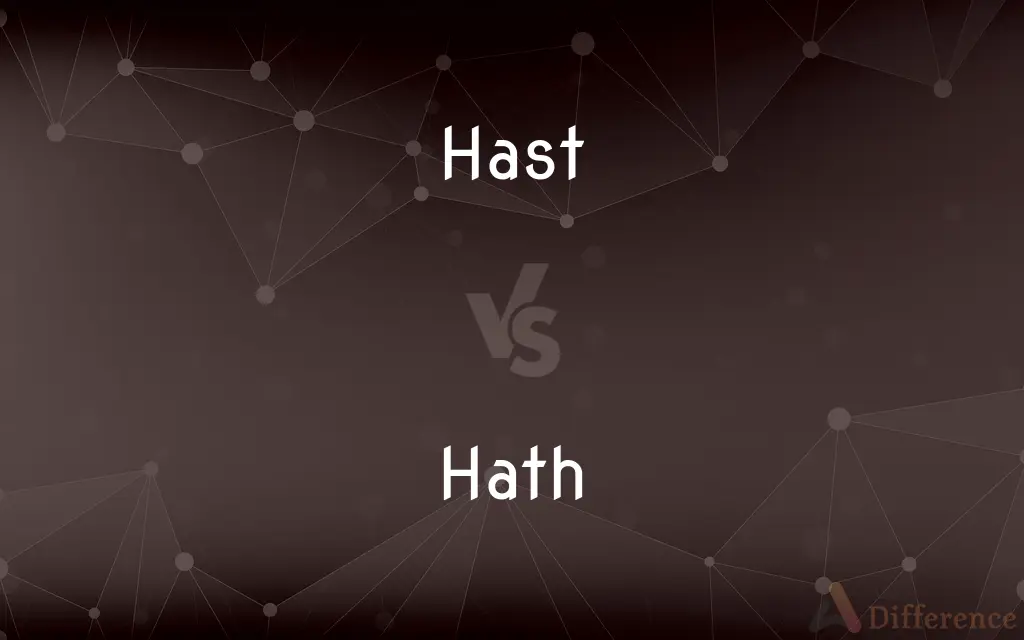Hast vs. Hath — What's the Difference?
By Fiza Rafique & Urooj Arif — Updated on March 26, 2024
Hast is the second person singular present form of "have," used historically or in literary contexts, indicating possession or necessity (e.g., Thou hast). Hath is the third person singular present form, also used in similar contexts (e.g., He hath).

Difference Between Hast and Hath
Table of Contents
ADVERTISEMENT
Key Differences
Hast is primarily used in archaic English or within poetic and religious texts to denote the second person singular present tense of "have." It signifies possession, necessity, or obligation directed towards "thou" or "you" in a formal or historical context. Whereas, Hath is similarly archaic, denoting the third person singular present tense of "have," used to describe possession, necessity, or obligation related to "he," "she," or "it."
In usage, "hast" is often found in classic literature and translations of texts from periods when Early Modern English was prevalent, giving a formal or old-fashioned tone to the narration or dialogue. On the other hand, "hath" is utilized in a similar manner but specifically refers to a single third person subject, embedding a sense of antiquity or solemnity in the expression.
The distinction between "hast" and "hath" also reflects the grammatical person being addressed or described. "Hast" directly addresses a second person subject, involving the reader or listener more intimately. Whereas "hath" creates a slight distance, as it refers to someone else, not directly involved in the conversation.
In contemporary use, both "hast" and "hath" are rarely employed in everyday conversation or writing, relegated instead to specific contexts where a historical or formal tone is desired. This contrasts with the modern "have" or "has," which have taken their place in regular discourse.
Despite their differences, both forms serve as a reminder of the flexibility and evolution of language, illustrating how English has simplified its conjugations over time. While "hast" and "hath" are not used in modern practical situations, they continue to enrich literary and historical works with their unique flavor.
ADVERTISEMENT
Comparison Chart
Grammatical Person
Second person singular (thou)
Third person singular (he, she, it)
Usage Context
Archaic, poetic, religious
Archaic, poetic, religious
Indicates
Possession, necessity, obligation
Possession, necessity, obligation
Contemporary Equivalence
Have (in modern English)
Has (in modern English)
Example Sentence
"Thou hast a friend in me."
"He hath no equal."
Compare with Definitions
Hast
Archaic second person singular present of "have."
Thou hast the information needed.
Hath
Archaic third person singular present of "have."
He hath a secret to tell.
Hast
Used historically for formal or poetic effect.
Thou hast been warned of the consequences.
Hath
Utilized in literature and religious texts.
She hath found her calling.
Hast
Reflects Early Modern English usage.
Thou hast a strong will.
Hath
Signifies possession, obligation, or necessity.
It hath become necessary to act.
Hast
Implies a direct address in text or speech.
Thou hast my gratitude.
Hath
Conveys a formal or old-fashioned tone.
He hath a sense of honor.
Hast
Indicates possession or necessity.
Thou hast a choice to make.
Hath
Demonstrates historical English grammar.
The sun hath risen.
Hast
Hast (Persian: هست) is a village in Hana Rural District, in the Central District of Semirom County, Isfahan Province, Iran. At the 2006 census, its population was 190, in 45 families.
Hath
Third person singular present tense of have.
Hast
Second person singular present tense of have.
Hath
Has.
What hath God wrought?
Hast
En-archaic second-person singular of have
Thou hast lovely eyes!
Thou hast left me alone.
Thou hast made me endless... -Ravindranath Thakur, Song Offerings, Poem 1
Common Curiosities
What does "hast" mean?
"Hast" is the archaic second person singular present tense of "have," indicating possession or obligation.
How do "hast" and "hath" relate to modern English?
They correspond to the modern "have" and "has," respectively, but are specific to archaic grammar forms.
Can "hast" and "hath" be used in modern English?
While grammatically correct, they are rarely used outside of specific contexts like poetry, historical texts, or for stylistic effect.
Does "hath" imply a singular or plural subject?
Singular; it's used for "he," "she," or "it."
Is it correct to use "hast" when speaking to someone directly?
Yes, if aiming for an archaic or formal tone, as it addresses the second person singular.
In what kind of literature are "hast" and "hath" most often found?
In classic literature, religious scriptures, and poetry that uses Early Modern English.
How do "hast" and "hath" compare with "have" and "has"?
"Hast" and "hath" are the archaic equivalents of "have" and "has," used in specific historical or stylistic contexts.
Where is "hath" typically used?
"Hath" is used in historical, religious, or literary contexts to denote third person singular present possession or necessity.
Why are "hast" and "hath" no longer commonly used?
Language evolution has simplified English conjugations, making these forms obsolete in everyday communication.
Are "hast" and "hath" interchangeable?
No, they serve different grammatical persons – second and third person singular, respectively.
What does the use of "hast" imply about the speaker or writer?
It may suggest the speaker or writer is aiming for a traditional, elevated, or stylized language choice.
What is the significance of using "hast" or "hath" today?
Their use today mainly adds a historical or formal nuance to language, invoking a sense of antiquity.
Can using "hast" or "hath" change the tone of a piece of writing?
Yes, their usage can impart a formal, old-fashioned, or solemn tone to the text.
Is it necessary to understand "hast" and "hath" for modern English speakers?
While not essential for everyday communication, knowing them can enhance understanding of historical and literary texts.
How does the use of "hast" or "hath" affect readability?
It may make texts seem more formal or archaic, potentially affecting readability for contemporary audiences unfamiliar with these forms.
Share Your Discovery

Previous Comparison
Tilt vs. Lean
Next Comparison
Hurdle vs. HurtleAuthor Spotlight
Written by
Fiza RafiqueFiza Rafique is a skilled content writer at AskDifference.com, where she meticulously refines and enhances written pieces. Drawing from her vast editorial expertise, Fiza ensures clarity, accuracy, and precision in every article. Passionate about language, she continually seeks to elevate the quality of content for readers worldwide.
Co-written by
Urooj ArifUrooj is a skilled content writer at Ask Difference, known for her exceptional ability to simplify complex topics into engaging and informative content. With a passion for research and a flair for clear, concise writing, she consistently delivers articles that resonate with our diverse audience.















































